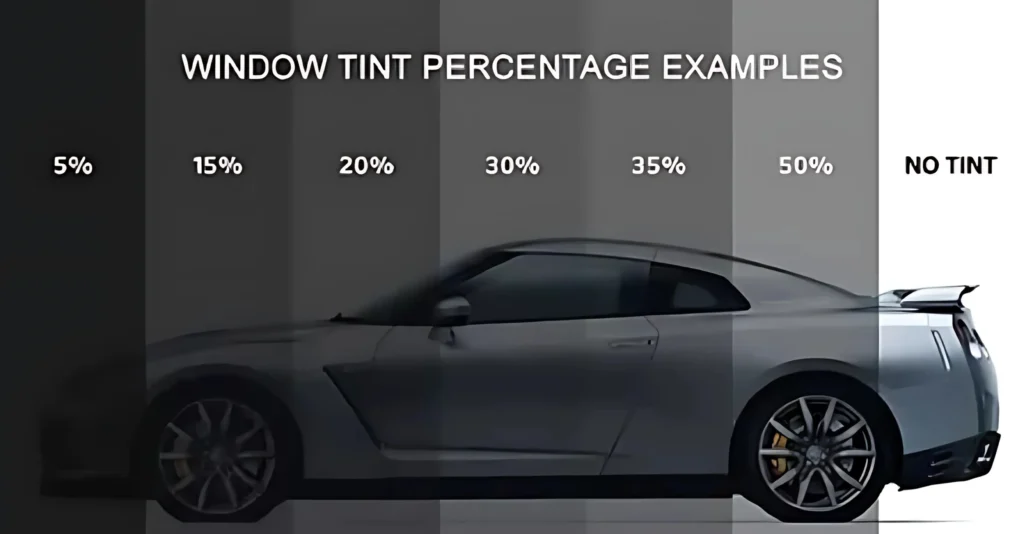To fully understand this law, it’s essential to learn about the different types of window tinting.
Different types of tint percentages
-
- Description: This is the lightest tint, allowing 70% of visible light to pass through the window.
-
- Effect: Provides a slight reduction in glare and UV protection without significantly affecting visibility.
-
- Common Use: Often used on windshields or in states with strict tint laws. It’s also a popular choice for those who want to reduce heat and UV exposure while maintaining a clear view of the outside.
-
- Compliance: This tint percentage is usually legal in most states, as it allows enough light to pass through.
-
- Description: Allows 50% of visible light to pass through the window, providing moderate tint.
-
- Effect: Offers a balance between UV protection, heat reduction, and visibility. It helps reduce glare but still allows good visibility, making it a popular option for front side windows.
-
- Common Use: Common for the driver’s side and passenger side windows in areas where slightly darker tints are allowed.
-
- Description: Allows 35% of visible light to pass through the window.
-
- Effect: Provides a noticeable reduction in glare and heat, offering more privacy while still ensuring adequate visibility from inside the vehicle.
-
- Common Use: This is a popular choice for back windows and rear side windows for privacy and protection against UV rays.
-
- Compliance: Many states allow 35% tint on rear windows, but front windows may have stricter regulations.
-
- Description: Allows 20% of visible light to pass through, making it one of the darker tints available.
-
- Effect: Provides significant privacy, reduces heat, and blocks a higher percentage of UV rays. However, it can significantly reduce visibility, especially at night.
-
- Common Use: Often used on rear windows or for those who prioritize privacy and aesthetic appearance.
-
- Compliance: Many states have restrictions on using such dark tint on the front windows, as it can impair visibility.
5% Tint (Limo Tint)
-
- Description: This is the darkest tint, allowing only 5% of visible light to pass through.
-
- Effect: Offers maximum privacy and UV protection but drastically reduces visibility, especially at night. It’s commonly used in limousines or vehicles requiring high levels of privacy.
-
- Common Use: Typically applied to rear windows or for show cars and limousines. Not recommended for front windows due to visibility concerns.
- Compliance: This is generally illegal on front side windows and windshields in many states, but may be allowed on rear and back windows.

When selecting the right tint percentage for your car, consider the following factors:
-
- State Laws: Always check your local window tint laws to ensure your tint percentage is legal. Laws can vary significantly depending on the state and even the city.
-
- Visibility and Safety: Ensure that your tint percentage doesn’t impair your ability to drive safely, especially at night.
-
- Privacy and Protection: Choose a tint that balances privacy, UV protection, and heat reduction according to your needs.
legal tint for windshield
Tint Allowed: Non-reflective tint is permitted only on the AS-1 line or the top 5 inches of the windshield.
Legal Tint for Front Side Windows
Tint Allowed: Must allow more than 35% of light to pass through.
Legal tint for Back Side Windows
Tint Allowed: Any darkness level is permitted.
Legal tint for Rear Window
Tint Allowed: Any darkness level is permitted.
Legal tint for Restricted Tint Colors
Prohibited Colors: Red, yellow, and amber tints are not legal.
Legal tint for Reflective tint
Prohibition: Tints with a metallic or mirrored appearance are not allowed.
legal tint for Side Mirrors
Requirement: If the rear window is tinted, dual side mirrors are required.
Legal tint for Medical Exemptions
Eligibility: Individuals with medical conditions requiring sun protection can apply for a waiver. A written certification from a licensed Maryland physician is necessary.
Legal tint for Penalties for Non-Compliance
Consequences: Violations can result in a Safety Equipment Repair Order (SERO), requiring correction within 10 days and certification within 30 days. Failure to comply may lead to fines.
Manufacturer Certification
- Requirement: Window tint manufacturers must certify that their products are in Maryland. It’s advisable to ensure your installer uses certified films.
We provide the best car tinting services in Maryland, ensuring quality and compliance with state laws. Our services are easily accessible from the following areas:
You can visit us from these nearby locations:
Youtube video for our services
